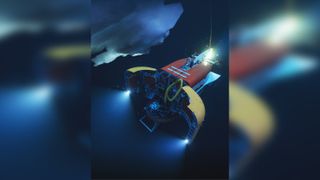Robotic sub will explore underside of Greenland's glaciers in a first
Scientists hope to find out how fast these rivers of ice are moving.

An upcoming robotic dive to the underside of Greenland's glaciers may reveal how much these rivers of ice will contribute to sea-level rise.
The mission, scheduled for midsummer 2023, will send a robotic submersible to the bottom of the outlets of three glaciers: Kangilliup Sermia, Umiammakku Sermiat and Kangerlussuup Sermia. All three are on Greenland's west coast. And just like all glaciers, these swaths of ice flow; in particular, they move ice from Greenland's interior to the ocean, making their dynamics important for understanding sea-level rise as the Arctic melts. This is the first time scientists will have a close-up view under the large island's glaciers.
"The big uncertainty in Greenland's contribution to sea-level rise is how fast the ice sheet is going to lose mass," Ginny Catania, a professor at the University of Texas Jackson School of Geosciences who is leading the voyage, said in a statement. "We know how much sea-level is stored in the ice sheet, we know climate is warming and changing the ice sheet, but what we don't know is the rate at which these glaciers will contribute to sea-level rise."
Related: 6 mysterious structures hidden beneath the Greenland ice sheet

To find out, Catania and her colleagues will deploy a remotely operated sub named Nereid Under Ice (NUI) to the underside of the glaciers where they reach the ocean. NUI will focus not on the ice itself, but on the walls of sand and sediment that the glacier pushes out ahead of itself as it flows. These earthen barriers are known as moraines, and they help stabilize the ice like a plug keeping water from flowing down a drain. The question is, if the plug is pulled, what will happen?
The sub will map the topography of the moraines and take sediment cores, which will help researchers better understand how stable the moraines are. The sub will also collect sediment samples from the sediment plume that flows out under the glacial ice.
Some scientists have suggested that the effects of global warming on sea-level rise could be delayed if some method was used to build up these submarine moraines, propping up the Greenland ice sheet. The research will help inform whether that idea has any merit, according to UT Austin.
Sign up for the Live Science daily newsletter now
Get the world’s most fascinating discoveries delivered straight to your inbox.
"This is high-risk, high-reward science, but it's exactly the kind of bold step needed to tackle the pressing and societally relevant questions about climate change and geohazards," Demian Saffer, director of the University of Texas Institute for Geophysics, one of the co-partners in the research, said in the statement. "If it succeeds, it could transform our understanding of sea level rise."
Operating under the harsh conditions along the Greenland coast is no easy matter. NUI will be connected to a research vessel by a thin fiber optic cable 10 miles (16 kilometers) long. If the cable snaps, the sub can pilot itself back to the surface using acoustics and is programmed to return to a pre-programmed pickup location if communication fails.
Originally published on Live Science.

Stephanie Pappas is a contributing writer for Live Science, covering topics ranging from geoscience to archaeology to the human brain and behavior. She was previously a senior writer for Live Science but is now a freelancer based in Denver, Colorado, and regularly contributes to Scientific American and The Monitor, the monthly magazine of the American Psychological Association. Stephanie received a bachelor's degree in psychology from the University of South Carolina and a graduate certificate in science communication from the University of California, Santa Cruz.
Most Popular

